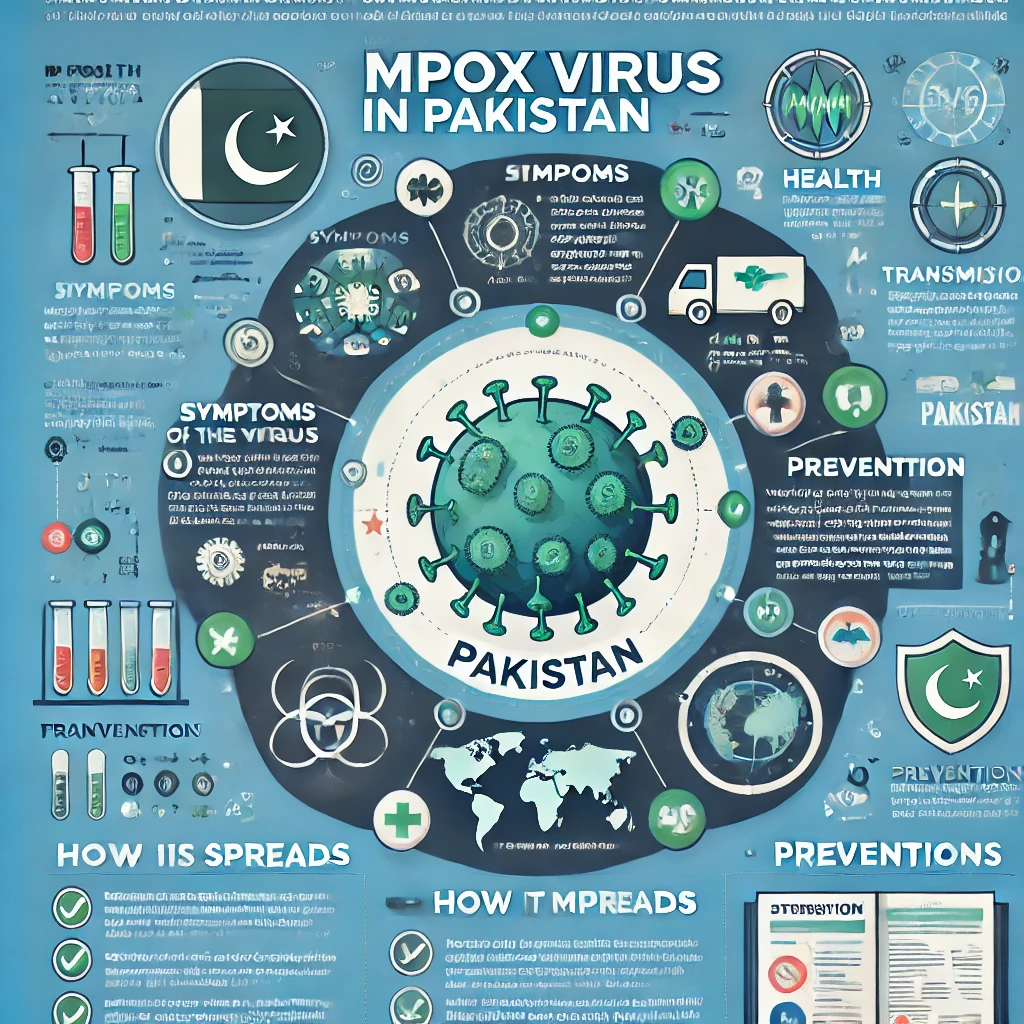The Mpox virus, also known as Monkeypox, has recently emerged as a significant health concern in Pakistan. Although it is a relatively rare disease, the rise in cases has caused alarm among health officials and the general public. Understanding the virus, its symptoms, how it spreads, and methods of prevention is crucial in controlling its spread.
Introduction to the Mpox Virus In Pakistan
Mpox is a viral zoonosis, meaning it is transmitted from animals to humans. The virus is part of the Orthopoxvirus genus, which also includes the variola virus (which causes smallpox) and the vaccinia virus (used in the smallpox vaccine). While Mpox is less severe than smallpox, it still poses a significant public health challenge, especially in areas where the virus is not commonly found, like Pakistan.
Symptoms of Mpox
Mpox symptoms usually begin with fever, headache, muscle aches, and exhaustion. One of the most noticeable symptoms is swollen lymph nodes, which distinguishes it from other similar diseases like smallpox. After a few days, a rash typically develops, starting on the face and then spreading to other parts of the body, including the palms of the hands and soles of the feet. The rash goes through several stages, from macules (flat lesions) to pustules (raised lesions filled with pus), before eventually scabbing over and falling off.

How Mpox Spreads
Mpox is primarily spread through close contact with infected animals or humans. In humans, it can be transmitted via respiratory droplets, bodily fluids, or direct contact with lesions. The virus can also be spread by touching contaminated clothing or bedding. While the exact animal reservoir for the virus is unknown, rodents are suspected to play a significant role in its transmission to humans.
Prevention of Mpox
Preventing the spread of Mpox requires a combination of personal and public health measures. Individuals should avoid close contact with infected persons or animals, practice good hand hygiene, and use protective equipment when caring for infected individuals. Public health strategies include surveillance, isolation of infected individuals, and vaccination campaigns in areas with high transmission rates. The smallpox vaccine is effective in preventing Mpox, providing cross-protection against the virus.
Impact of Mpox in Pakistan
In recent months, Pakistan has seen a gradual increase in Mpox cases. The healthcare system is currently monitoring the situation closely, with efforts being made to contain the spread of the virus. Public awareness campaigns are being launched to educate people on the symptoms and prevention methods. Although the number of cases is still relatively low, the potential for wider spread remains a concern, particularly in densely populated areas.
Government Response
The Pakistani government has taken several measures to address the Mpox outbreak. This includes setting up isolation wards in hospitals, conducting mass awareness campaigns, and collaborating with international health organizations for better disease management. The government is also ensuring the availability of vaccines for those at higher risk of contracting the virus, such as healthcare workers and individuals in close contact with infected persons.
Challenges in Controlling the Virus
Despite the efforts, several challenges remain in controlling the spread of Mpox in Pakistan. One of the major issues is the lack of public awareness and understanding of the virus. Additionally, the healthcare system faces challenges in terms of resource allocation and capacity to handle an outbreak, especially in rural areas. Moreover, the stigma associated with the disease can lead to underreporting of cases, further complicating control efforts.

The Role of International Organizations
International organizations such as the World Health Organization (WHO) and the Centers for Disease Control and Prevention (CDC) are working closely with the Pakistani government to provide technical support and resources. These organizations are helping to enhance surveillance, improve diagnostic capabilities, and ensure that the necessary vaccines and treatments are available.
Future Outlook
The future outlook for Mpox in Pakistan depends on the effectiveness of the current control measures and public cooperation. Continued efforts in surveillance, vaccination, and public education are essential to prevent a larger outbreak. With timely intervention and effective management, it is hoped that the spread of the virus can be contained, minimizing its impact on public health.
مپوکس وائرس ایک خطرناک بیماری ہے جو انسانوں میں جانوروں سے منتقل ہوتی ہے۔ پاکستان میں اس کے کیسز بڑھ رہے ہیں، جس کی وجہ سے صحت کے ادارے احتیاطی تدابیر پر زور دے رہے ہیں۔ احتیاطی تدابیر اپنانا ضروری ہے تاکہ اس بیماری سے بچا جا سکے۔
FAQs
Q1: What are the common symptoms of Mpox?
Common symptoms of Mpox include fever, headache, muscle aches, swollen lymph nodes, and a rash that spreads across the body.
Q2: How does Mpox spread?
Mpox spreads through close contact with infected individuals, animals, or contaminated materials like bedding or clothing.
Q3: Is there a vaccine for Mpox?
Yes, the smallpox vaccine has been found effective in providing protection against Mpox.
Q4: What measures has the Pakistani government taken to control the Mpox outbreak?
The government has set up isolation wards, launched awareness campaigns, and is collaborating with international organizations for better disease management.
The Mpox virus is a serious health concern that requires prompt and effective action. Understanding the virus, recognizing the symptoms, and following prevention guidelines are critical steps in protecting yourself and your community. Stay informed and take the necessary precautions to reduce the risk of infection.
